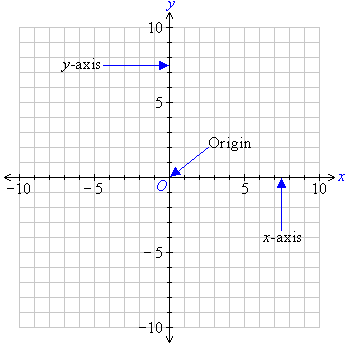| The Cartesian plane consists of two directed
lines that perpendicularly intersect their respective zero points.

The horizontal directed
line is called the x-axis and the vertical directed line is called the y-axis.
The point of intersection of the x-axis and the y-axis is
called the origin and is denoted by the letter O.
The Coordinates
The position of any point on the Cartesian plane is described by using
two numbers: (x, y). The first number, x,
is the horizontal position of the point from the origin. It is called
the x-coordinate. The second number, y, is the vertical
position of the point from the origin. It is called the y-coordinate.
Since a specific order is used to represent the coordinates, they are
called ordered pairs.

For example, the ordered pair (5, 8) represents a point 5 units to the
right of the origin in the direction of the x-axis and 8 units above the
origin in the direction of the y-axis as shown in the diagram
below.
We say that:
The x-coordinate of point P is 5; and the y-coordinate
of point P is 8.
Or simply, we can say that:
The coordinates of point P are (5, 8).

Note the following:
- For the point P(5, 8), the ordered pair is (5, 8). So:
5 is the x-coordinate, and
8 is the y-coordinate.
- P(5, 8) means P is 5 units to the right of and 8 units
above the
origin.
Example 1
State the coordinates of each of the points shown on the Cartesian plane:

Solution:
A is 3 units to the right of and 2 units above the origin. So,
point A is (3, 2).
B is 5 units to the right of and 5 units above the origin. So,
point B is (5, 5).
C is 7 units to the right of and 8 units above the origin. So,
point C is (7, 8).
D is 6 units to the left of and 4 units above the origin. So,
point D is (–6, 4).
E is 3 units to the left of and 7 units above the origin. So,
point E is (–3, 7).
F is 4 units to the left of and 6 units below the origin. So,
point F is (–4, –6).
G is 8 units to the left of and 8 units below the origin. So,
point G is (–8, –8).
P is 9 units to the right of and 9 units below the origin. So,
point P is (9, –9).
Q is 6 units to the right of and 5 units below the origin. So,
point Q is (6, –5).
Key Terms
Cartesian plane, x-axis, y-axis, origin, coordinates, point, x-coordinate, y-coordinate, ordered
pair |